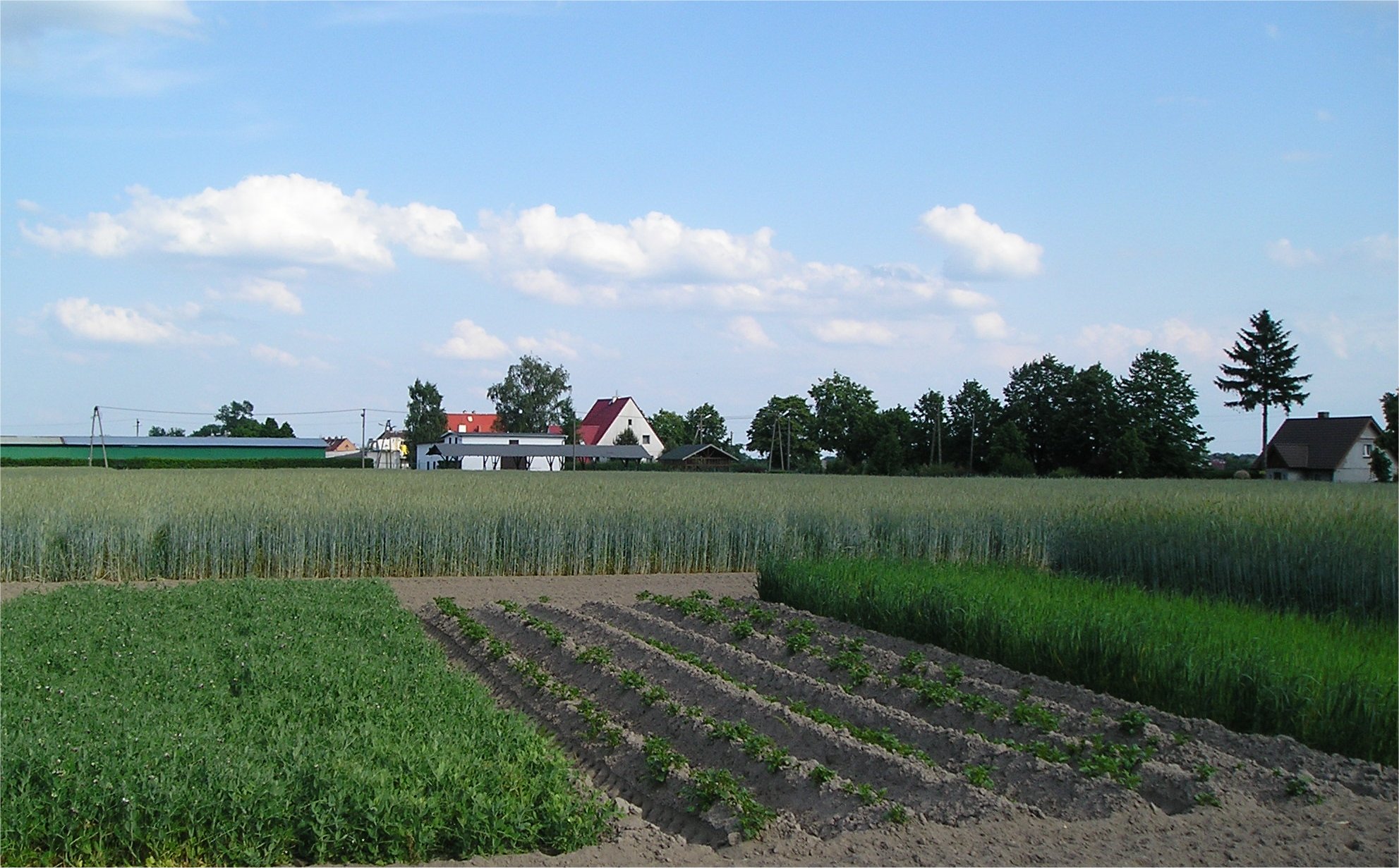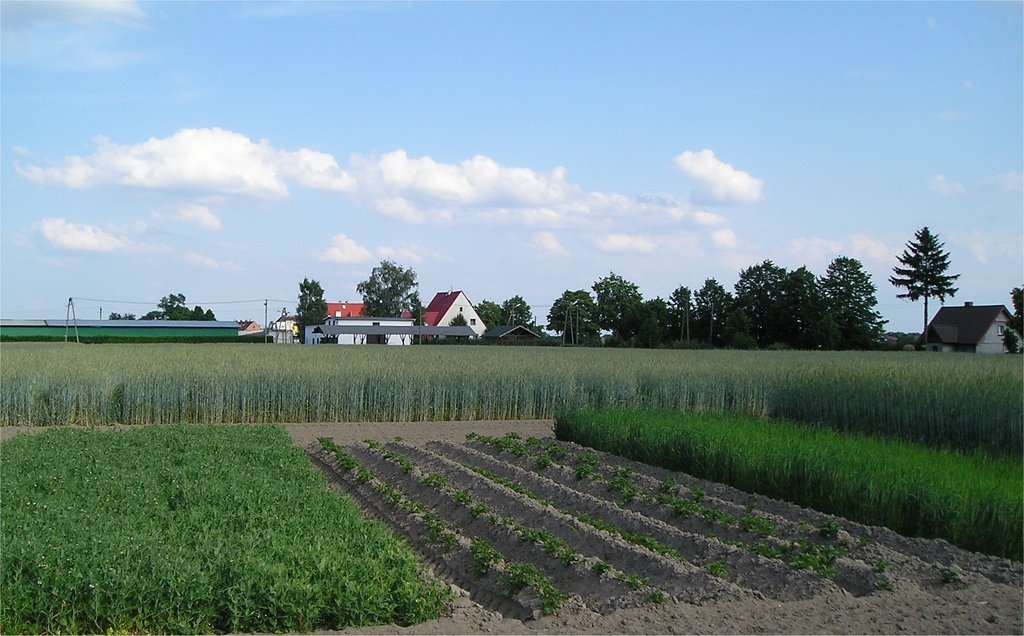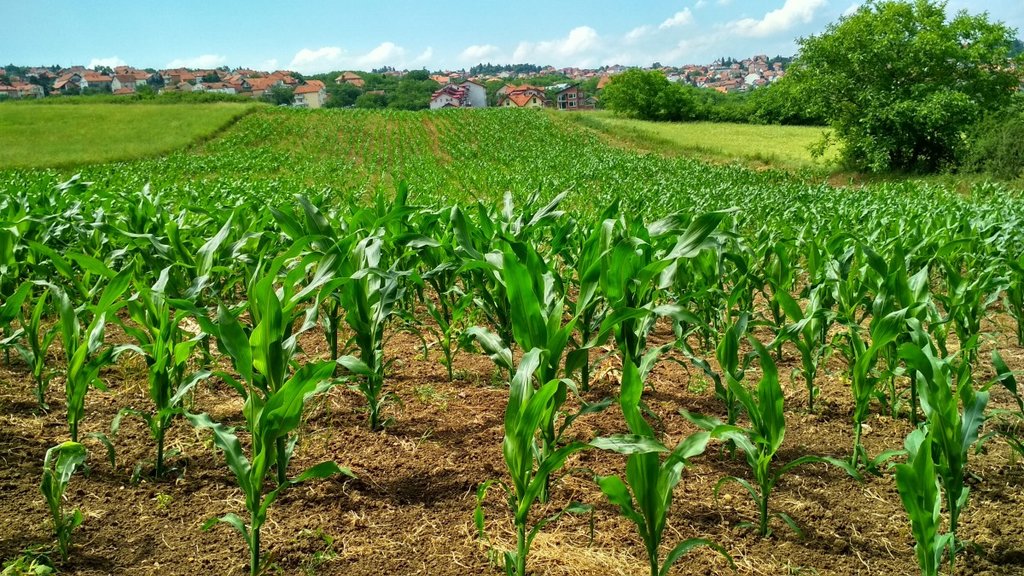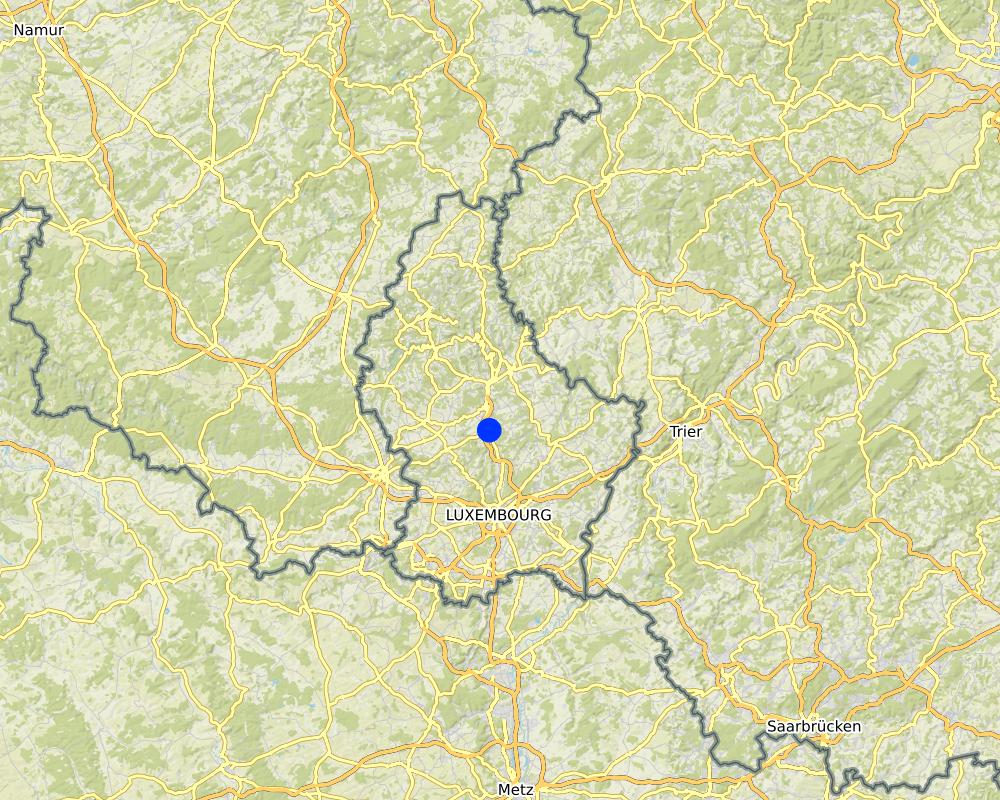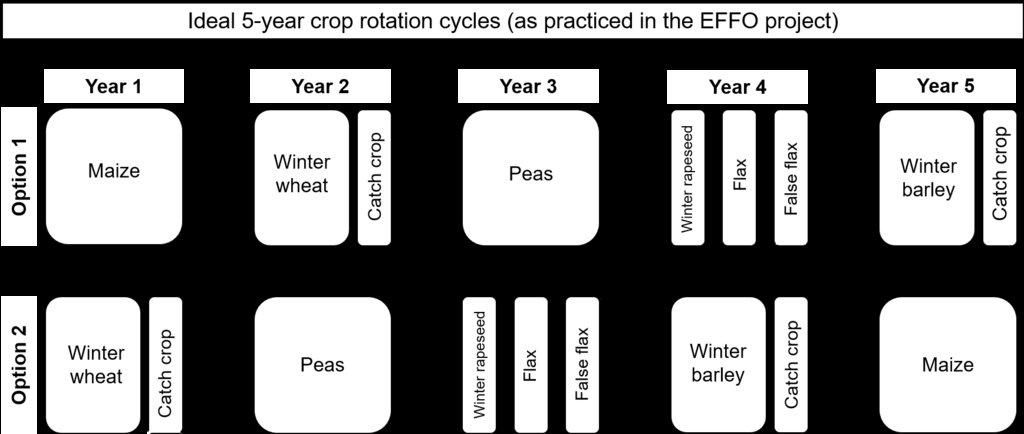Common Agricultural Policy (CAP) agri-environment-climate measure: Rotation program [Luxembourg]
- Creation:
- Update:
- Compiler: Sabine Reinsch
- Editor: David Robinson
- Reviewer: Rima Mekdaschi Studer
AUK-Fruchtfolgeprogramm
technologies_5617 - Luxembourg
View sections
Expand all Collapse all1. General information
1.2 Contact details of resource persons and institutions involved in the assessment and documentation of the Technology
Key resource person(s)
co-compiler:
Conter Gérard
Lycée technique Agricole, Ettelbrück
Luxembourg
SLM specialist:
Richarz Frank
Landwirtschaftlech Kooperatioun Uewersauer (LAKU)
Luxembourg
SLM specialist:
Altmann Gilles
Institut fir biologesch Landwirtschaft an Agrarkultur Luxemburg (IBLA)
Luxembourg
Name of project which facilitated the documentation/ evaluation of the Technology (if relevant)
European Interreg project FABulous FarmersName of the institution(s) which facilitated the documentation/ evaluation of the Technology (if relevant)
UK Centre for Ecology & Hydrology (CEH) - United Kingdom1.3 Conditions regarding the use of data documented through WOCAT
The compiler and key resource person(s) accept the conditions regarding the use of data documented through WOCAT:
Yes
1.4 Declaration on sustainability of the described Technology
Is the Technology described here problematic with regard to land degradation, so that it cannot be declared a sustainable land management technology?
No
2. Description of the SLM Technology
2.1 Short description of the Technology
Definition of the Technology:
Rotation program: Diverse rotation of at least five crops on farm level for more biodiversity and less intensive cultivation practice
2.2 Detailed description of the Technology
Description:
The Common Agricultural Policy (CAP) agri-environment-climate measure aims to increase diversification of arable crops to overcome negative impacts of monocultures. The technology described here focuses on the benefit of the rotation programme focusing on 5-year rotation cycles (although CAP aid is only paid with at least 5 different crops planted in any given year). The program applies to all arable crops on the farm, with the exception of permanent or temporary meadows and pastures.
The allocation of the CAP aid is subject to compliance with the following conditions:
At least five different arable crops must be grown during a crop year (as part of the crop rotation programme)
The minimum area per crop shall not be less than 10 per cent of the total area of arable crops on the farm
The share of maize cannot exceed 30 percent
The same crop cannot be grown more than twice on the same field during the commitment period (5 years)
The conversion of permanent pastures and pasture to arable land is forbidden on the whole farm area
The annual aid per hectare is:
- 100€ if total surface of arable land on the farm is less than 50 hectares
- 75€ if total surface of arable land on the farm is between 50 and 100 hectares
- 60€ if total surface of arable land on the farm is above 100 hectares.
Utilised agricultural area (UAA) in Luxembourg is composed to >50% of permanent grassland (due to pedologic and topographic reasons); more than 70% of UAA is used for fodder production. The fodder is used in cattle production (mainly dairy cows). In the past years the arable production concentrated very much on maize (=>easy and reliable fodder plant) and winter wheat (=> good economic results). On many farms, the rotation degrades to a 2 years rotation: maize – wheat, maize – wheat, … with negative impacts on the soil, problematic weeds, high inputs (fertilisers, pesticides, …). The aim of the CAP agri-environment-climate measure: Rotation program was to reverse this tendency and to give incentives to bring farmers back to longer rotations (at least 5 years). On a short perspective these are less profitable (and have to be financially compensated) but on a long-term view they have many ecological (and economic) benefits. The EFFO-Project (Effizienz durch Fortbildung = Efficiency by Edification) is a demonstration project, run on three pilot farms showing the advantages and practicability of longer rotations and helping thus to implement these in practice.
Benefits of the CAP rotation program:
- reduced land degradation and increased soil health by reduction of soil erosion
- conservation of ecosystems
- protection of water courses and therewith increasing water availability and quality
- increased (bio)diversity by increasing plant and associated fauna diversity
- reduced disaster risks (rainstorms, heatwaves, droughts) due to higher plant diversity and thus increased resilience
- increased crop and fodder quality
Strengths of the technology according to the users:
- higher resilience of the cropping system
- advantage of receiving CAP payments
- positive impact on soil structure and (bio) diversity
- positive impact on (drinking) water quantity and quality
Disadvantages of the technology:
- increased administrative burden
- increased planning of crop rotations needed (more complicated to organise)
The compilation of this SLM is a part of the European Interreg project FABulous Farmers which aims to reduce the reliance on external inputs by encouraging the use of methods and interventions that increase the farm’s Functional AgroBiodiversity (FAB). Visit www.fabulousfarmers.eu and www.nweurope.eu/Fabulous-Farmers for more information.
2.3 Photos of the Technology
2.5 Country/ region/ locations where the Technology has been applied and which are covered by this assessment
Country:
Luxembourg
Region/ State/ Province:
Entire country
Further specification of location:
Arable land
Specify the spread of the Technology:
- evenly spread over an area
If the Technology is evenly spread over an area, specify area covered (in km2):
70060000.0
If precise area is not known, indicate approximate area covered:
- > 10,000 km2
Is/are the technology site(s) located in a permanently protected area?
No
Map
×2.6 Date of implementation
Indicate year of implementation:
2014
If precise year is not known, indicate approximate date:
- less than 10 years ago (recently)
2.7 Introduction of the Technology
- CAP
Comments (type of project, etc.):
CAP = Common Agricultural Policy
https://ec.europa.eu/info/food-farming-fisheries/key-policies/common-agricultural-policy/cap-glance_en
3. Classification of the SLM Technology
3.1 Main purpose(s) of the Technology
- reduce, prevent, restore land degradation
- conserve ecosystem
- protect a watershed/ downstream areas – in combination with other Technologies
- preserve/ improve biodiversity
- reduce risk of disasters
3.2 Current land use type(s) where the Technology is applied
Land use mixed within the same land unit:
No

Cropland
- Annual cropping
Annual cropping - Specify crops:
- cereals - barley
- cereals - maize
- cereals - wheat (winter)
- fibre crops - flax, hemp, other
- legumes and pulses - peas
Number of growing seasons per year:
- 1
Is intercropping practiced?
Yes
If yes, specify which crops are intercropped:
any type of catch crop; different species inter-cropped in different regions of the country
Is crop rotation practiced?
Yes
If yes, specify:
Maize, winter wheat, peas, winter rapeseed, flax, false flax, winter barley
3.3 Has land use changed due to the implementation of the Technology?
Has land use changed due to the implementation of the Technology?
- No (Continue with question 3.4)
Land use mixed within the same land unit:
No
3.4 Water supply
Water supply for the land on which the Technology is applied:
- rainfed
3.5 SLM group to which the Technology belongs
- rotational systems (crop rotation, fallows, shifting cultivation)
- ecosystem-based disaster risk reduction
3.6 SLM measures comprising the Technology

agronomic measures
- A1: Vegetation/ soil cover

management measures
- M2: Change of management/ intensity level
3.7 Main types of land degradation addressed by the Technology

soil erosion by water
- Wt: loss of topsoil/ surface erosion

biological degradation
- Bc: reduction of vegetation cover
- Bh: loss of habitats
- Bq: quantity/ biomass decline
- Bl: loss of soil life
- Bp: increase of pests/ diseases, loss of predators
3.8 Prevention, reduction, or restoration of land degradation
Specify the goal of the Technology with regard to land degradation:
- prevent land degradation
- reduce land degradation
4. Technical specifications, implementation activities, inputs, and costs
4.1 Technical drawing of the Technology
Technical specifications (related to technical drawing):
Across Luxembourg, sizes of fields and farms vary. Ideal 5-year crop rotation cycles are suggested as part of the EFFO project to maximise benefits of the crop rotations.
https://www.list.lu/en/research/project/effo
Author:
EFFO project
Date:
09/10/2019
4.2 General information regarding the calculation of inputs and costs
Specify how costs and inputs were calculated:
- per Technology area
Indicate size and area unit:
7006 ha
other/ national currency (specify):
€
If relevant, indicate exchange rate from USD to local currency (e.g. 1 USD = 79.9 Brazilian Real): 1 USD =:
0.91
4.3 Establishment activities
| Activity | Timing (season) | |
|---|---|---|
| 1. | change from a two years rotation (wheat-maize) to a diverse five years rotation | annually |
4.4 Costs and inputs needed for establishment
| Specify input | Unit | Quantity | Costs per Unit | Total costs per input | % of costs borne by land users | |
|---|---|---|---|---|---|---|
| Labour | laber total | 1.0 | 69.0 | 69.0 | ||
| Plant material | seeds | 1.0 | 130.0 | 130.0 | 100.0 | |
| Fertilizers and biocides | Fertilizer | 1.0 | 164.0 | 164.0 | ||
| Fertilizers and biocides | Herbizide | 1.0 | 145.0 | 145.0 | ||
| Other | additional | 1.0 | 37.0 | 37.0 | ||
| Total costs for establishment of the Technology | 545.0 | |||||
| Total costs for establishment of the Technology in USD | 598.9 | |||||
Comments:
Costs are for a total area of 5 ha planted over 5 years with: 1) winter wheat, 2) peas, 3) rapeseed, 4) winter barley, 5) maize.
This crop rotation results in a rotation benefit of €100.
Data retrieved from the "Fruchtfolgerechner" of the EFFO.
4.7 Most important factors affecting the costs
Describe the most determinate factors affecting the costs:
Yields, market prices, logistical difficulties
5. Natural and human environment
5.1 Climate
Annual rainfall
- < 250 mm
- 251-500 mm
- 501-750 mm
- 751-1,000 mm
- 1,001-1,500 mm
- 1,501-2,000 mm
- 2,001-3,000 mm
- 3,001-4,000 mm
- > 4,000 mm
Specifications/ comments on rainfall:
In the last years extreme weather conditions (rainfall, drought, …) are happening more and more often.
Healthy soils (on the basis of large rotations) are more resilient towards these extreme weather situations.
Agro-climatic zone
- humid
- sub-humid
5.2 Topography
Slopes on average:
- flat (0-2%)
- gentle (3-5%)
- moderate (6-10%)
- rolling (11-15%)
- hilly (16-30%)
- steep (31-60%)
- very steep (>60%)
Landforms:
- plateau/plains
- ridges
- mountain slopes
- hill slopes
- footslopes
- valley floors
Altitudinal zone:
- 0-100 m a.s.l.
- 101-500 m a.s.l.
- 501-1,000 m a.s.l.
- 1,001-1,500 m a.s.l.
- 1,501-2,000 m a.s.l.
- 2,001-2,500 m a.s.l.
- 2,501-3,000 m a.s.l.
- 3,001-4,000 m a.s.l.
- > 4,000 m a.s.l.
Indicate if the Technology is specifically applied in:
- not relevant
5.3 Soils
Soil depth on average:
- very shallow (0-20 cm)
- shallow (21-50 cm)
- moderately deep (51-80 cm)
- deep (81-120 cm)
- very deep (> 120 cm)
Soil texture (topsoil):
- coarse/ light (sandy)
- medium (loamy, silty)
Soil texture (> 20 cm below surface):
- coarse/ light (sandy)
- medium (loamy, silty)
Topsoil organic matter:
- medium (1-3%)
If available, attach full soil description or specify the available information, e.g. soil type, soil PH/ acidity, Cation Exchange Capacity, nitrogen, salinity etc.
from a pH below 5 in the north to a pH above 7 in the south (also check Soil acidity map of Luxembourg: www.geoportail.lu)
5.4 Water availability and quality
Ground water table:
5-50 m
Availability of surface water:
good
Water quality (untreated):
good drinking water
Water quality refers to:
ground water
Is water salinity a problem?
No
Is flooding of the area occurring?
No
5.5 Biodiversity
Species diversity:
- low
Habitat diversity:
- low
Comments and further specifications on biodiversity:
Maize and winter wheat as main crops are not very beneficial to a (bio-) diversity. One of the goals of the described Technology is to improve (bio-) diversity
5.6 Characteristics of land users applying the Technology
Sedentary or nomadic:
- Sedentary
Market orientation of production system:
- commercial/ market
Off-farm income:
- less than 10% of all income
Relative level of wealth:
- rich
- very rich
Individuals or groups:
- individual/ household
Level of mechanization:
- mechanized/ motorized
Age of land users:
- middle-aged
Indicate other relevant characteristics of the land users:
Mainly family farms
5.7 Average area of land used by land users applying the Technology
- < 0.5 ha
- 0.5-1 ha
- 1-2 ha
- 2-5 ha
- 5-15 ha
- 15-50 ha
- 50-100 ha
- 100-500 ha
- 500-1,000 ha
- 1,000-10,000 ha
- > 10,000 ha
Is this considered small-, medium- or large-scale (referring to local context)?
- medium-scale
5.8 Land ownership, land use rights, and water use rights
Land ownership:
- individual, not titled
Land use rights:
- individual
Water use rights:
- communal (organized)
Are land use rights based on a traditional legal system?
No
5.9 Access to services and infrastructure
health:
- poor
- moderate
- good
education:
- poor
- moderate
- good
technical assistance:
- poor
- moderate
- good
employment (e.g. off-farm):
- poor
- moderate
- good
markets:
- poor
- moderate
- good
energy:
- poor
- moderate
- good
roads and transport:
- poor
- moderate
- good
drinking water and sanitation:
- poor
- moderate
- good
financial services:
- poor
- moderate
- good
6. Impacts and concluding statements
6.1 On-site impacts the Technology has shown
Socio-economic impacts
Production
crop quality
fodder quality
risk of production failure
product diversity
Water availability and quality
drinking water availability
drinking water quality
water availability for livestock
water quality for livestock
Income and costs
expenses on agricultural inputs
Comments/ specify:
also through CAP subsidies
farm income
Comments/ specify:
also through CAP subsidies
workload
Socio-cultural impacts
food security/ self-sufficiency
health situation
cultural opportunities
recreational opportunities
SLM/ land degradation knowledge
Ecological impacts
Water cycle/ runoff
water quantity
water quality
harvesting/ collection of water
surface runoff
excess water drainage
groundwater table/ aquifer
evaporation
Soil
soil moisture
soil loss
soil compaction
nutrient cycling/ recharge
soil organic matter/ below ground C
Biodiversity: vegetation, animals
plant diversity
beneficial species
habitat diversity
pest/ disease control
Climate and disaster risk reduction
flood impacts
drought impacts
emission of carbon and greenhouse gases
micro-climate
6.2 Off-site impacts the Technology has shown
water availability
reliable and stable stream flows in dry season
groundwater/ river pollution
buffering/ filtering capacity
damage on public/ private infrastructure
6.3 Exposure and sensitivity of the Technology to gradual climate change and climate-related extremes/ disasters (as perceived by land users)
Gradual climate change
Gradual climate change
| Season | increase or decrease | How does the Technology cope with it? | |
|---|---|---|---|
| annual temperature | increase | well | |
| seasonal temperature | winter | increase | well |
| seasonal temperature | spring | increase | well |
| seasonal temperature | summer | increase | well |
| seasonal temperature | autumn | increase | well |
| seasonal rainfall | winter | decrease | well |
| seasonal rainfall | spring | decrease | well |
| seasonal rainfall | summer | decrease | well |
| seasonal rainfall | autumn | decrease | well |
Climate-related extremes (disasters)
Meteorological disasters
| How does the Technology cope with it? | |
|---|---|
| local rainstorm | well |
Climatological disasters
| How does the Technology cope with it? | |
|---|---|
| heatwave | well |
| drought | well |
Hydrological disasters
| How does the Technology cope with it? | |
|---|---|
| general (river) flood | very well |
6.4 Cost-benefit analysis
How do the benefits compare with the establishment costs (from land users’ perspective)?
Short-term returns:
slightly negative
Long-term returns:
positive
How do the benefits compare with the maintenance/ recurrent costs (from land users' perspective)?
Short-term returns:
neutral/ balanced
Long-term returns:
positive
6.5 Adoption of the Technology
- 11-50%
Of all those who have adopted the Technology, how many did so spontaneously, i.e. without receiving any material incentives/ payments?
- 0-10%
6.6 Adaptation
Has the Technology been modified recently to adapt to changing conditions?
No
6.7 Strengths/ advantages/ opportunities of the Technology
| Strengths/ advantages/ opportunities in the land user’s view |
|---|
| More resilient cropping system |
| Possibility to receive CAP-payments |
| Positive impact on soil structure + life |
| Strengths/ advantages/ opportunities in the compiler’s or other key resource person’s view |
|---|
| More resilient cropping system |
| Positive impacts on (drinking) water production + quality |
6.8 Weaknesses/ disadvantages/ risks of the Technology and ways of overcoming them
| Weaknesses/ disadvantages/ risks in the land user’s view | How can they be overcome? |
|---|---|
| administrative burden | unknown |
| more complicated to organise because more crops need to be handled | unknown/more practice with time |
| Weaknesses/ disadvantages/ risks in the compiler’s or other key resource person’s view | How can they be overcome? |
|---|---|
| higher percentage of participating farmers | unknown |
7. References and links
7.1 Methods/ sources of information
- field visits, field surveys
- interviews with SLM specialists/ experts
When were the data compiled (in the field)?
01/10/2019
Comments:
Part of EFFO-Project and Interreg FabulousFarmers
7.3 Links to relevant online information
Title/ description:
Homepage Chamber of agriculture
URL:
https://www.lwk.lu/pflanzenbauberatung/effo-effiziente-fruchtfolgen-und-wasserschutz
Title/ description:
Homepage LTA
URL:
https://www.lta.lu/effo.html
Title/ description:
Homepage LIST
URL:
https://www.list.lu/en/research/project/effo/
Title/ description:
Homepage Ministry of agriculture
URL:
https://agriculture.public.lu/de/beihilfen/agrar-klima-umwelt/agrar-umwelt-klimamassnahmen/fruchtfolgeprogramm.html
Links and modules
Expand all Collapse allLinks
No links
Modules
No modules


